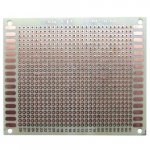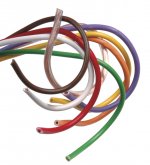Enzo Ferrari will remember a GT40 has an "ordinary Ford engine".Or is it more like a Volvo with just an ordinary Ford engine?
In a certain sense, P2P is one kind of PCB. Different layout & routing causes parameter differences.
No it isn't you cannot get a proper ground plane...it is outdated these days for modern electronics PCB gives you so much more control and the ability to maximise signal integrity and EMC issues.
I'm in the process of reading your Thread again. I gave up at about post50 last time.My bad...
I don't see the need to separate into MF, HF decoupling grounds. ......................................increases as that ground resistor is increased.
........
I'll find our differences as I progress.
Well, for some 10 components of a simple chip-amp that's OK if it's done right.Do you mean having a sheet of copper?
Normal point to point usually involves just wires...
Traditional P2P -- eg as seen in vintage guitar amplifiers and radios, old lab equipment etc -- uses a steel or copper chassis and turret/eyelet boards to mechanically support components. Sometimes metal/copper subchassis are used for certain assemblies for shielding.
Thanks for the measurements and posts here and on your website. It is nice to have all of this pulled together in one spot. Especially since creating and assembling the content is a time consuming task.
You're welcome. It certainly is a time-consuming task. Though, it's a distraction from the business side of things, posting my conclusions on the LM3886 is a rewarding way to give back to the DIY community. Hopefully, that's reciprocated in terms of donations or board sales.
Do you plan to post a picture of the back of the board?
Nope. My plan is to continue to publish data and to continue to demonstrate the value proposition of my circuit. You'll be able to deduce all the secret sauce from my Taming the LM3886 page, however, you have to apply the knowledge to your own circuit yourself.
~Tom
I'm in the process of reading your Thread again. I gave up at about post50 last time.
I'll find our differences as I progress.
Stop reading. Start thinking. Then start a circuit simulator... Just saying.
You have the foundation for success. Just run some simulations. I'd be surprised if you arrive at a different conclusion than I. After all, physics is the same on your side of the planet as it is on mine.
~Tom
the only simulations I am any good at are the ones I develop in my head and write down on paper.
LTspice is way beyond my memory capabilities, but I am still trying.
I already have my thinking cap on.
That's where I got my suggestion from which you threw in the bin because I did not give you a long-winded explanation of why it should work.
You called it "emotion".
LTspice is way beyond my memory capabilities, but I am still trying.
I already have my thinking cap on.
That's where I got my suggestion from which you threw in the bin because I did not give you a long-winded explanation of why it should work.
You called it "emotion".
the only simulations I am any good at are the ones I develop in my head and write down on paper.
Nothing wrong with developing a hypothesis in your head. You need to test the hypothesis somehow, though. What do you do for that?
LTspice is way beyond my memory capabilities, but I am still trying.
Is this a common problem in the DIY community? There is a learning curve, but I could easily type up a web page on the topic.
I already have my thinking cap on.
That's where I got my suggestion from which you threw in the bin because I did not give you a long-winded explanation of why it should work.
The following is intended as constructive criticism of your communication style. My intent is to give you insight into how I perceive your communication. Judging by some of the comments you've received on DIY Audio, I suspect I'm not the only one who perceives your communication this way. My intent is for us to be able to better work together rather than butting heads. I hope you're interested in this. If not, please let me know so I can direct my energy elsewhere.
A lot of times you tend to communicate in condensed, cryptic packets. The idea in your head may be a good one, but it doesn't seem to transfer cleanly onto DIY Audio, hence, it is often hard to follow what you're saying.
You also tend to state your opinion in absolutes. "You must do X", in some cases without defining what X is. "You must follow Best Practices", for example. A link to the Best Practices would be helpful.
My end of that is that I don't deal well with orders. To me, "you must do X" seems like an order. That's my problem, not yours necessarily. To be able to understand your idea, it is important to me to get the reasons why. It doesn't have to be a long winded explanation. A schematic or drawing that shows the explanation, some math, or a paragraph or two of detail to get me on the same page as you would be helpful.
If you can draw a schematic and can use a multimeter, you can do magic with LTspice.
Yep. You just have to know the basic types of simulation:
DC = calculates operating points and node voltages
AC = calculates node voltages vs frequency (useful for simulating gain and stability)
Transient = calculates node voltages as function of time.
You forgot to mention the ability to remember the key strokes to tell the sim what questions you want to ask.
The questions you ask the simulator are the same as those you ask of the circuit in the lab. Of course, with the ideal sources in the simulator, you can take some shortcuts to get results quicker. For example, if you were to measure the output impedance of an amplifier, you can hook an ideal current source to the output of the amp and run an AC simulation. That will tell you the output impedance as function of frequency. Nothing prevents you from using the same methodology as you would in the lab, however. Connect two different load resistors and calculate the output impedance from the resulting change in output voltage.
~Tom
I totally understand. After a while it gets old to repeat yourself. That was one of the drivers behind my Taming the LM3886 page. Then I can just point people there and move on.
Your short responses would be more helpful if you pointed to a lengthy post you typed in the past (link to the post). A link to a website on the topic would be useful as well. That takes a little more work, but it would greatly improve the usefulness of your responses. You'll probably find that to be a better use of your time.
Just a suggestion...
I appreciate your inputs. It's always good to be able to have a technical discussion with someone and push the state of the art.
~Tom
Your short responses would be more helpful if you pointed to a lengthy post you typed in the past (link to the post). A link to a website on the topic would be useful as well. That takes a little more work, but it would greatly improve the usefulness of your responses. You'll probably find that to be a better use of your time.
Just a suggestion...
I appreciate your inputs. It's always good to be able to have a technical discussion with someone and push the state of the art.
~Tom
Last edited:
And then Tom's all like: You're be better off focusing your energy elsewhere, my grey matter impedance is too high for any further neurological stimulation to occur in my prefrontal cortex 
Then I'm all like: Oh yeah?!
I'm going to use this (1st pic)
and these (second pic)
Then this guy (third pic)
To make this (4th pic)
Then I'm all like: Oh yeah?!
I'm going to use this (1st pic)
and these (second pic)
Then this guy (third pic)

To make this (4th pic)
Attachments
Too much introspective reflection for you? 
Andrew and I have butted heads more than once, even though we agree on many things. I value his contributions but would value them even more if he made a small tweak to his communication style. It's my general observation that I have a higher chance of getting what I want if I ask for what I want. So I encouraged Andrew to change his communication style a bit. I did this because it would make his contributions even more useful to me, but also because it would make his contributions more accessible and useful to the DIY Audio community as a whole.
I asked Andrew to let me know if my suggestions were welcome. If they aren't, I'd rather just let it go and move on. I don't enjoy banging my head against the wall.
~Tom
Andrew and I have butted heads more than once, even though we agree on many things. I value his contributions but would value them even more if he made a small tweak to his communication style. It's my general observation that I have a higher chance of getting what I want if I ask for what I want. So I encouraged Andrew to change his communication style a bit. I did this because it would make his contributions even more useful to me, but also because it would make his contributions more accessible and useful to the DIY Audio community as a whole.
I asked Andrew to let me know if my suggestions were welcome. If they aren't, I'd rather just let it go and move on. I don't enjoy banging my head against the wall.
~Tom
Have you used the black speaker terminal as your Main Audio Ground?
Where is the Power Ground?
Are the two sets of decoupling capacitors and the Output Zobel connected to the Power Ground?
Does every circuit follow strictly the two wire close coupled pairs technique?
that is not what I think I can see.
Take the input pair.
The red with is presumably signal.
The black wire must then be signal return.
It starts off as a twisted pair.
The black drops off and is connected to the black capacitors. WHY?
The red wire continues alone. It has lost it's close coupled partner.
The components on the left pair of terminals cannot be the Output Zobel. They are not mounted on the Output pin and the HF decoupled Power Ground.
I could go on.
I asked the questions to prompt you into looking again at your P2P assembly.
To me, it just does not follow any good practice.
Mark states:
Here are my two posts.Andrew and I have butted heads more than once, even though we agree on many things. I value his contributions but would value them even more if he made a small tweak to his communication style. ...........
The only part that gets close to "telling you" what to do is this
What did I do wrong?I asked the questions to prompt you into looking again at your P2P assembly.
- Home
- Amplifiers
- Chip Amps
- LM3886 PCB vs Point-to-Point (with data)



